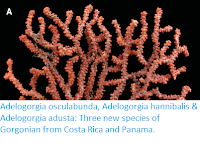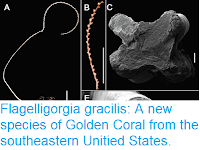Scleractinian Corals are first appeared around the end of the Ordovician, and since the Triassic have been the major component of Coral Reefs around the world. However, these Corals appear to be threatened today by rising sea temperatures and novel pathogens, both of which have caused widespread bleaching (loss of symbiotic zooxanthellae) and Coral dieback, with potentially disastrous consequences for reef-dwelling communities, which rely on these Corals to build and maintain these habbits. However, there is a single non-Scleractinian reef-building Coral alive today, the sole species of the reef-building Octocoral group, Helioporidae. Heliopora coerulea is present on many reefs today, and forms the dominant constructing species on a number of Pacific Reefs, including Boliano Reef in the Phillippines, Shiraho Reef in Japan, Bikini Atoll in the Marshall Islands, and Tarawa Atoll in Kiribati. This species, known as the Blue Coral due to its distinctive blue skeleton, has apparently been around since the Cretaceous, when fossils identical to the modern form begin to appear. Importantly, the Blue Coral is apparently immune to bleaching, and populations of Blue Corals have survived a number of bleaching incidents in which Scleractinian Corals on the same reefs were more-or-less wiped out.
In a paper published in the journal Scientific Reports on 26 October 2018, Zoe Richards of the Western Australian Museum and the Trace and Environmental DNA Laboratory at Curtin University, Nina Yasuda of the Organization for Promotion of Tenure Track at University of Miyazaki, Taisei Kikuchi of Parasitology at the University of Miyazaki, Taryn Foster of the Australian Institute of Marine Science, Chika Mitsuyuki of the Field Science Center at Tohoku University, Michael Stat, also of the Trace and Environmental DNA Laboratory at Curtin University, and of the Department of Biological Sciences at Macquarie University, Yoshihisa Suyama, also of the Field Science Center at Tohoku University, and Nerida Wilson, also of the Western Australian Museum and the University of Western Australia, describe a second species of Heliopora from the reefs of northern Western Australia.
Octocorals are colonial Corals, Anthozoa, usually lacking the extensive
mineralised skeletons of Stony Corals. Each polyp of the colony has only
eight tentacles, giving the group its name, though these often have
numerous side branches, giving them a feathery appearance.
The new species is named Heliopora hiberniana, in reference to Hibernia Reef, where it was first discovered during a survey of Corals on the reef. The first specimens were noticed because, while they resembled Heliopora coerulea in form they had a white, rather than a blue skeleton. Subsequent DNA analysis of these Corals found that while Heliopora coerulea always has a blue skeleton, Heliopora hiberniana can have either a blue or a white skeleton.
Heliopora hiberniana growing in situ on Hibernia Reef. (A) Branching clump growing in close association with Halimeda sp., (B) Small branching clump. (C) Heliopora hiberniana (top) growing in situ with Heliopora coerulea (bottom) at the type locality. (D) Heliopora hiberniana. with a broken branch showing the white skeleton, (E) Side attached open branching colony with encrusting base; (F) Heliopora hiberniana (background) growing in situ with Stylophora pistillata in the foreground. Richards et al. (2018).
Heliopora hiberniana forms tightly branching clumps up to 40 cm in diameter, with main branches club-shaped and up to 30 cm in length. The branches are rounded, but tend to flatten towards their tips. The species has been found Hibernia Reef, Ashmore Reef, Browse Island, and Scott Reef, off the coast of northern Western Australia; it is unclear to what extent (if any) it is found elsewhere. The observed specimens were living at depths of between one and twelve meters.
See also...
Follow Sciency Thoughts on Facebook.







